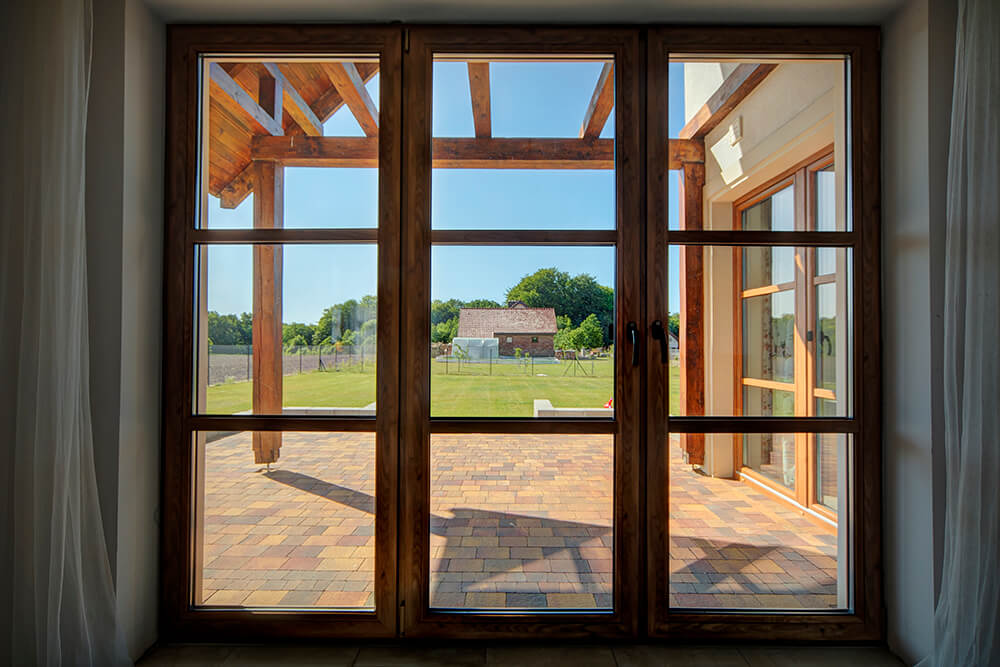Due to the extensive construction and transport infrastructure, protection against noise is becoming more and more important in our lives. Therefore, windows should not only provide an adequate amount of light in the room and have good thermal insulation, but also protect the house from external noise. The noise damping factor is used to determine the extent to which a glazed unit damps sound.
What determines the soundproofing ability of window?
The acoustic insulation of the window undoubtedly depends on the glazed unit. The following factors affect how well a glazed unit deals with noise reduction:
- type of glass (float or laminated, with or without acoustic foil),
- the order of the location of individual panes in the glazed unit,
- thickness of each of the glass used,
- distance between individual glass panes (width of the spacer bar),
- type of gas filling cavities between panes,
- surface of the glass.

How does noise affect our organism?
Noise is measured in units called decibels (dB). It is worth knowing that our ears do not perceive excessive intensity sounds in a linear manner. For example: noise reduction by 3 dB is not felt to a large extent, while a reduction of the sound level by 10 dB is treated as a noise reduction by half. There is no doubt that noise has a bad influence on us. It causes fatigue, nervousness and a reduction in work efficiency. Additionally, very loud sounds can damage hearing and disturb the functioning of the nervous system.

What does the noise reduction coefficient inform about?
The noise reduction coefficient Rw is a parameter that indicates the difference between external and internal noise. Its value is calculated as a weighted average of sixteen measurements carried out for different sound frequencies. It is given with two parameters – C and Ctr. They reduce the value of the noise reduction coefficient depending on the type of noise source. The C parameter is called the spectrum adaptation term for high and medium frequency sounds, such as e.g. a passing plane or nearby traffic. Ctr is a spectrum adaptation term for low and medium frequency sounds. It is used, inter alia, in with regard to muffled music and distant traffic.
Example:
Rw(C;Ctr) = 40 dB(-1;-2)
In the example shown, parameter C reduces the value of the noise reduction coefficient by 1 dB and Ctr by 2 dB.
Acoustic insulation of acoustic glazed units
The following tables show the properties of the most popular acoustic glazed units.
Double glazed units |
||||||
|---|---|---|---|---|---|---|
| Acoustic insulation[dB] | Structure of the glazed unit | |||||
| Rw | Rw | C | Ctr | Glass #1 | Spacer bar | Glass #2 |
| 35 | 35 | -2 | -7 | 6 | 16Ar | 33.1 |
| 36 | 36 | -2 | -6 | 8 | 16Ar | 4 |
| 37 | 37 | -1 | -5 | 44.2 | 16Ar | 4 |
| 38 | 38 | -1 | -5 | 8 | 14Ar | 6 |
| 39 | 39 | -1 | -5 | 44.1A | 16Ar | 4 |
| 40 | 40 | -1 | -4 | 8 | 20Ar | 44.2 |
| 41 | 41 | -2 | -6 | 8 | 12Ar | 44.1A |
| 42 | 42 | -2 | -6 | 44.2A | 20Ar | 6 |
| 43 | 43 | -2 | -6 | 55.2A | 20Ar | 6 |
| 44 | 44 | -2 | -6 | 44.1A | 20Ar | 8 |
| 45 | 45 | -1 | -4 | 10 | 16Ar | 66.2A |
| (33.1; 44.1; 44.2; 55.2, 66.2) – laminated glass; A – acoustic foil | ||||||
Triple glazed units |
|||||||
|---|---|---|---|---|---|---|---|
| Acoustic insulation [dB] | Structure of the glazed unit | ||||||
| Rw | C | Ctr | Glass #1 | Spacer bar | Glass #2 | Spacer bar | Glass #3 |
| 35 | -1 | -6 | 4 | 12Ar | 4 | 12Ar | 33.1 |
| 36 | -2 | -6 | 33.1 | 12Ar | 6 | 12Ar | 4 |
| 37 | -2 | -6 | 8 | 12Ar | 6 | 12Ar | 6 |
| 38 | -1 | -5 | 8 | 12Ar | 4 | 12Ar | 6 |
| 39 | -2 | -7 | 10 | 12Ar | 6 | 12Ar | 4 |
| 40 | -2 | -7 | 6 | 12Ar | 6 | 12Ar | 44.2 |
| 41 | -3 | -8 | 6 | 12Ar | 6 | 12Ar | 44.2A |
| 42 | -1 | -6 | 6 | 12Ar | 4 | 12Ar | 44.2A |
| 43 | -2 | -6 | 8 | 12Ar | 6 | 12Ar | 55.2 |
| 44 | -2 | -7 | 8 | 12Ar | 6 | 12Ar | 55.2A |
| 45 | -2 | -7 | 44.4 | 14Ar | 4 | 14Ar | 44.4A |
| (33.1; 44.1; 44.2; 55.2, 66.2) – laminated glass; A – acoustic foil | |||||||
The following conclusions can be drawn from the above tables:
- differentiating the thickness of individual panes in one glazed unit allows to achieve a higher value of noise reduction coefficient;
- increasing the thickness of the glass pane has a positive effect on noise reduction by a glazed unit;
- the use of acoustic foil in laminated glass makes the glazed unit provide better protection against noise.
The influence of the frame on the acoustic insulation of the window
The parameters described do not apply to the entire window, but only to glazed units. The resultant Rw value for a complete element is also influenced by the construction of the frame structure. In the case of glazed units with worse noise reduction coefficient (Rw ≤ 40 dB), the frame structure contributes to the increase of the value of the total acoustic insulation index. If, on the other hand, the glazed unit has better acoustic insulation (Rw > 42 dB), the frame structure lowers the ability of window to reduce noise. In such a situation, it has worse insulating properties compared to the glass.


